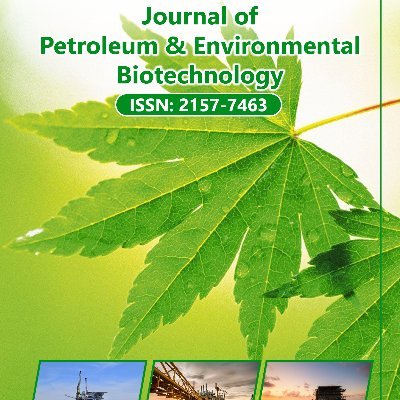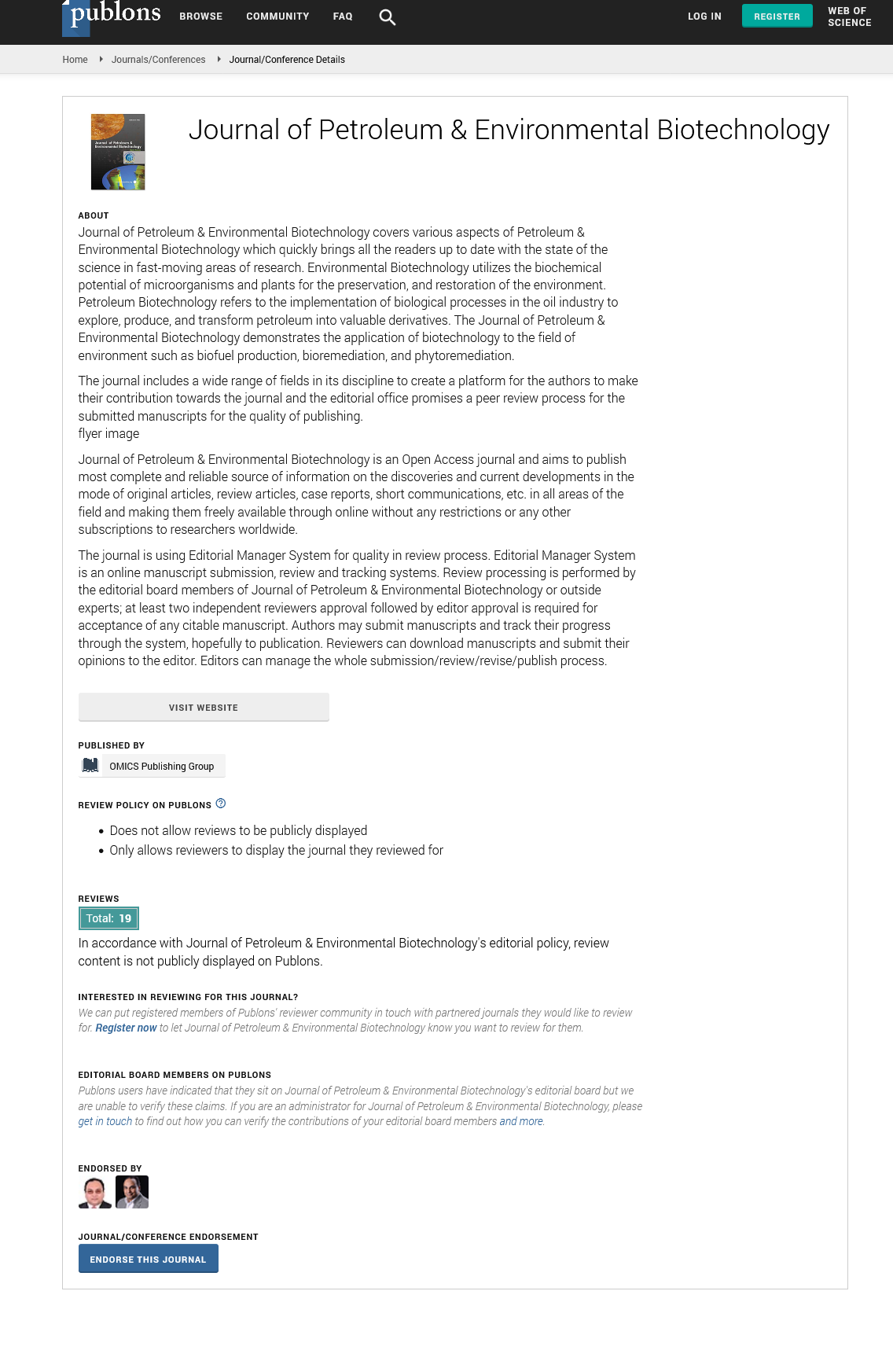Indexed In
- Open J Gate
- Genamics JournalSeek
- JournalTOCs
- China National Knowledge Infrastructure (CNKI)
- Electronic Journals Library
- RefSeek
- Hamdard University
- EBSCO A-Z
- OCLC- WorldCat
- SWB online catalog
- Virtual Library of Biology (vifabio)
- Publons
- MIAR
- Euro Pub
- Google Scholar
Useful Links
Share This Page
Journal Flyer

Open Access Journals
- Agri and Aquaculture
- Biochemistry
- Bioinformatics & Systems Biology
- Business & Management
- Chemistry
- Clinical Sciences
- Engineering
- Food & Nutrition
- General Science
- Genetics & Molecular Biology
- Immunology & Microbiology
- Medical Sciences
- Neuroscience & Psychology
- Nursing & Health Care
- Pharmaceutical Sciences
Short Communication - (2024) Volume 15, Issue 4
Role of Biodegradation in Waste Management and Microbial Innovations for Modern Ecosystems
Thompson Garcia*Received: 25-Nov-2024, Manuscript No. JPEB-24-27940; Editor assigned: 29-Nov-2024, Pre QC No. JPEB-24-27940 (PQ); Reviewed: 13-Dec-2024, QC No. JPEB-24-27940; Revised: 20-Dec-2024, Manuscript No. JPEB-24-27940 (R); Published: 27-Dec-2024, DOI: 10.35248/2157-7463.24.15.591
Description
Biodegradation is a critical natural process where organic substances are broken down by living organisms, primarily microorganisms, into simpler compounds. This mechanism plays a pivotal role in maintaining ecological balance, mitigating pollution and promoting sustainable waste management. The process encompasses various biochemical and microbial pathways that transform complex organic compounds into non-toxic end products such as carbon dioxide, water and biomass. Biodegradation not only aids in the natural recycling of organic matter but also serves as a cornerstone in bioremediation technologies, which aim to clean contaminated environments [1].
The biodegradation in the metabolic capabilities of microorganisms, including bacteria, fungi and archaea. These microorganisms possess a diverse array of enzymes that catalyze the breakdown of complex molecules. The degradation pathway generally involves two stages primary biodegradation, where the chemical structure of a compound is altered and ultimate biodegradation, which leads to complete mineralization. This multi-step process depends on several factors, such as the nature of the substrate, environmental conditions and the microbial community present. Biodegradation can be classified into aerobic and anaerobic processes. Aerobic biodegradation occurs in the presence of oxygen and is often faster due to the high energy yield of aerobic metabolic pathways. This type of degradation is commonly observed in surface soils, freshwater systems and well aerated environments. Anaerobic biodegradation, on the other hand, occurs in oxygen-depleted conditions and relies on alternative electron acceptors such as nitrate, sulfate, or carbon dioxide. Anaerobic processes are slower but play a major role in ecosystems such as wetlands, deep-sea sediments and landfills [2].
The versatility of biodegradation is evident in its ability to address a wide range of organic compounds, including natural substances like plant and animal residues, as well as anthropogenic pollutants such as hydrocarbons, pesticides and plastics. For instance, hydrocarbons derived from petroleum products are among the most persistent pollutants in the environment. Microbial communities capable of degrading hydrocarbons utilize them as carbon and energy sources, transforming these compounds into less harmful substances. This capability is especially significant in mitigating the environmental impact of oil spills, where biodegradation serves as a natural attenuation process.
Similarly, the biodegradation of pesticides is vital for reducing their environmental persistence and toxicity. Many pesticides are designed to resist chemical and microbial breakdown to ensure effectiveness, but this also leads to environmental accumulation. Microbial degradation offers a solution by employing specialized bacteria and fungi that can metabolize these compounds, breaking them into less harmful metabolites. However, the efficiency of pesticide biodegradation often depends on factors such as soil pH, temperature and the presence of co-metabolites [3,4].
Plastic pollution has emerged as a pressing environmental challenge, with biodegradation offering a potential solution. Traditional plastics, derived from petrochemicals, are highly resistant to microbial attack due to their complex polymer structure. However, recent advances in biotechnology have identified microorganisms and enzymes capable of breaking down synthetic polymers such as polyethylene, polystyrene and polyethylene terephthalate. Biodegradable plastics, designed with more accessible chemical bonds, are also gaining popularity as they are more amenable to microbial degradation, reducing long term environmental impact [5-7].
Environmental conditions significantly influence the rate and extent of biodegradation. Key factors include temperature, pH, moisture, oxygen availability and nutrient concentration. Optimal conditions vary depending on the substrate and the microbial community involved. For example, hydrocarbon biodegradation in marine environments is influenced by salinity, temperature and the presence of dispersants, which can enhance microbial access to oil droplets. Similarly, the degradation of organic matter in soil is affected by moisture levels and aeration, which influence microbial activity and oxygen diffusion. The genetic and metabolic diversity of microorganisms is a cornerstone of biodegradation. Advances in molecular biology and Omics technologies have provided insights into the genes and enzymes involved in the degradation pathways of various compounds. Alkane hydroxylases and dioxygenases are key enzymes in hydrocarbon degradation, while lignin peroxidases and manganese peroxidases play major roles in breaking down complex plant polymers. Genetic engineering and synthetic biology are further expanding the potential of biodegradation by creating microbial strains with enhanced degradation capabilities [8-10].
Biodegradation also plays a central role in bioremediation, a technology that uses biological agents to clean contaminated environments. In situ bioremediation, where microorganisms degrade pollutants directly at the contamination site, is a cost effective and environmentally friendly approach. For example, bio augmentation involves introducing specific microbial strains to enhance the degradation process, while bio stimulation involves modifying environmental conditions, such as adding nutrients or electron acceptors, to promote microbial activity. Phytoremediation, which uses plants to assist in the degradation or stabilization of pollutants, is another promising strategy. Despite its potential, biodegradation faces challenges that limit its effectiveness in certain scenarios. The bioavailability of pollutants is a significant barrier, as many contaminants are hydrophobic and tend to adsorb onto soil particles or form aggregates, reducing microbial access. Additionally, some pollutants exhibit high toxicity or structural complexity, making them recalcitrant to microbial degradation. Strategies to overcome these challenges include the use of bio surfactants to enhance pollutant solubility, the application of advanced oxidation processes to pre-treat recalcitrant compounds and the development of microbial consortia with complementary metabolic pathways.
References
- Das N, Chandran P. Microbial degradation of petroleum hydrocarbons: An overview. Biotechnol Res Int. 2011;18(1):1-7.
[Crossref] [Google Scholar] [PubMed]
- Sivan A. New perspectives in plastic biodegradation. Curr Opin Biotechnol. 2011;22(3):422-426.
[Crossref] [Google Scholar] [PubMed]
- Kennedy M. The nonlinear effects of evolutionary innovation biospheric feedbacks on qualitative environmental change: From the microbial to metazoan world. The American Naturalist. 2013;181(S1):S100-S111.
[Crossref] [Google Scholar] [PubMed]
- Bull AT, Goodfellow M, Slater JH. Biodiversity as a source of innovation in biotechnology. Annu Rev Microbiol. 1992;46:219-252.
[Crossref] [Google Scholar] [PubMed]
- Calle F. Marine microbiome as source of natural products. Microb Biotechnol. 2017;10(6):1293.
[Crossref] [Google Scholar] [PubMed]
- Alexander M. Biodegradation: problems of molecular recalcitrance and microbial fallibility. Adv Appl Microbiol. 1965;7:35-80.
[Crossref] [Google Scholar] [PubMed]
- Jordan A, Gathergood N. Biodegradation of ionic liquids–a critical review. Chem Soc Rev. 2015;44(22):8200-8237.
[Crossref] [Google Scholar] [PubMed]
- Bakke T, Sanni S. Environmental impacts of produced water and drilling waste discharges from the Norwegian offshore petroleum industry. Mar Environ Res. 2013;92:154-169.
[Crossref] [Google Scholar] [PubMed]
- Lim BK, San Thian E. Biodegradation of polymers in managing plastic waste A review. Sci Total Environ. 2022;813:151880.
[Crossref] [Google Scholar] [PubMed]
- Cucina M, de Nisi P, Tambone F, Adani F. The role of waste management in reducing bioplastics’ leakage into the environment: A review. Bioresour Technol. 2021;337:125459.
[Crossref] [Google Scholar] [PubMed]
Citation: Garcia T (2024). Innovations in Technology and Environmental Impacts in Petroleum Exploration: Challenges and Opportunities for a Low-Carbon Future. J Pet Environ Biotechnol. 15:591.
Copyright: © 2024 Garcia T. This is an open-access article distributed under the terms of the Creative Commons Attribution License, which permits unrestricted use, distribution, and reproduction in any medium, provided the original author and source are credited.

